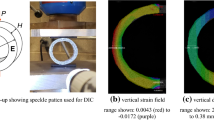Abstract
Natural fibers are promising for engineering applications due to their low cost. They are abundantly available in tropical and subtropical regions of the world, and they can be employed as construction materials. Among natural fibers, bamboo has been widely used for housing construction around the world. Bamboo is an optimized composite that exploits the concept of Functionally Graded Material (FGM). Biological structures such as bamboo have complicated microstructural shapes and material distribution, and thus the use of numerical methods such as the finite element method, and multiscale methods such as homogenization, can help to further understanding of the mechanical behavior of these materials. The objective of this work is to explore techniques such as the finite element method and homogenization to investigate the structural behavior of bamboo. The finite element formulation uses graded finite elements to capture the varying material distribution through the bamboo wall. To observe bamboo behavior under applied loads, simulations are conducted under multiple considerations such as a spatially varying Young’s modulus, an averaged Young’s modulus, and orthotropic constitutive properties obtained from homogenization theory. The homogenization procedure uses effective, axisymmetric properties estimated from the spatially varying bamboo composite. Three-dimensional models of bamboo cells were built and simulated under tension, torsion, and bending load cases.


















Similar content being viewed by others
References
Nogata F, Takahashi H (1995) Compos Eng 5:743
Janssen JJA (1995) Building with bamboo. Intermediate Technology Publications, London
Jayanetti DL, Follett PR (1998) Bamboo in construction. Trada, UK
Chung KF, Yu WK (2002) Eng Struct 24:429
Ghavami K (1995) Cement Concrete Compos 17:281
Okubo K, Fujii T, Yamamoto Y (2004) Compos Part A 35:377
Ge XC, Li XH, Meng YZ (2004) J Appl Polymer Sci 93:1804
Ghavami K (2004) Structure and Properties of Bamboo. PowerPoint presentation
Amada S, Munekata T, Nagase Y, Ichikawa Y, Kirigai A, Yang ZF (1996) J Compos Mat 30:800
Amada S, Ichikawa Y, Munekata T, Shimizu H (1997) Compos Part B 28:13
Ray AK, Das SK, Mondal S, Ramachandrarao P (2004) J Mater Sci 39:1055
Amada S, Ichikawa Y, Munekata T, Nagase Y, Shimizu H (1997) Compos Part B 28:13
Ghavami K, Rodrigues CS, Paciornik S (2003) Asian J Civil Eng 4:1
Janssen JJA (1991) Mechanical properties of bamboo. Kluwer Academic Publishers
Suresh S, Mortensen A (1988) Fundamentals of functionally graded materials. IOM Communications, London
Paulino GH, Jin Z-H, Dodds RH Jr (2003) In: Karihaloo B, Knauss WG (eds) Comprehensive structural integrity, vol 2. Elsevier, p 607
Lakkad SC, Patel JM (1980) Fibre Sci Tech 14:319
Lo TY, Cui HZ, Leung HC (2004) Mater Lett 58:2595
Li SH, Zeng QY, Xiao YL, Fu SY, Zhou BL (1995) Mat Sci Eng C 3:125
Amada S, Lakes RS (1997) J Mater Sci 32:2693
Amada S, Untao S (2001) Compos Part B 32:451
Nugroho N, Ando N (2001) J Wood Sci 47:237
Lee AWC, Bai XS, Bangi AP (1997) Forest Prod J 47:74
Amada S, Terauchi Y (2001) In: Trumble K, Bowman K, Reimanis I, Sampath S (eds) Proceedings of the 6th International Symposium of Functionally Graded Materials, Estes Park, Colorado, Sep. 2000. The American Ceramic Society, p 763
Bai XS, Lee AWC, Thompson LL, Rosowsky DV (1999) Wood Fiber Sci 31:403
Bathe K-J (1996) Finite element procedures. Prentice-Hall, Englewood Cliffs
Cook RD, Malkus DS, Plesha ME, Witt RJ (2002) Concepts and applications of finite element analysis 4th edn. John Wiley and Sons, USA
Sanchez-Palencia E (1980) Non-homogeneous media and vibration. Theory lecture notes in physics 127. Springer, Berlin
Santare MH, Lambros J (2000) ASME J Appl Mech 67:819
Kim J-H, Paulino GH (2002) ASME J Appl Mech 69:502
Yin HM, Sun LZ, Paulino GH (2004) Acta Mater 52:3535
Nemat-Nasser S, Hori M (1993) Micromechanics: overall properties of heterogeneous materials. North-Holland, Amsterdam
Kalamkarov AL, Kolpakov AG (1997) Analysis, design and optimization of composite structures. John Wiley and Sons, Chichester, England
Guedes JM, Kikuchi N (1990) Comp Meth Appl Mech Eng 83:143
Rooney F, Ferrari M (2001) Int J Solids Struct 38:413
Pindera MJ, Freed AD, Arnold SM (1993) Int J Solids Struct 30:1213
Walters MC, Paulino GH, Dodds RH Jr (2004) Int J Solids Struct 41:1081
Gere JM, Timoshenko SP (1990) Mechanics of Materials 3rd edn. PWS Publishing, Boston
Acknowledgements
We gratefully acknowledge the U.S. National Science Foundation through the project CMS #0303492 “Inter-Americas Collaboration in Materials Research and Education” (P.I., Professor W. Soboyejo, Princeton University).
Author information
Authors and Affiliations
Corresponding author
Rights and permissions
About this article
Cite this article
Silva, E.C.N., Walters, M.C. & Paulino, G.H. Modeling bamboo as a functionally graded material: lessons for the analysis of affordable materials. J Mater Sci 41, 6991–7004 (2006). https://doi.org/10.1007/s10853-006-0232-3
Published:
Issue Date:
DOI: https://doi.org/10.1007/s10853-006-0232-3




